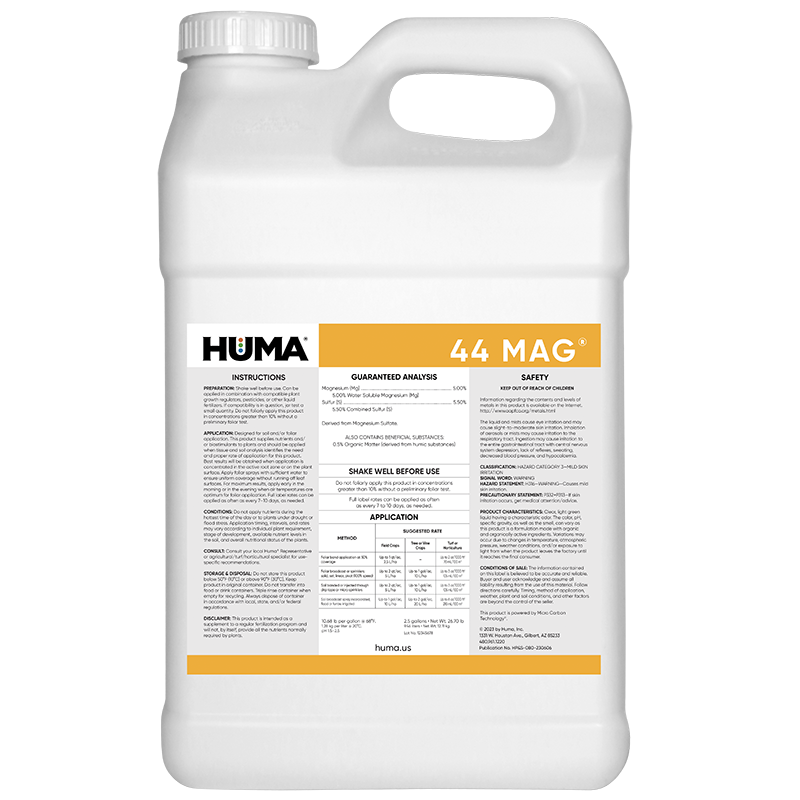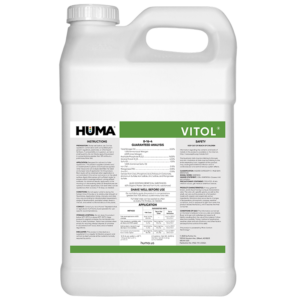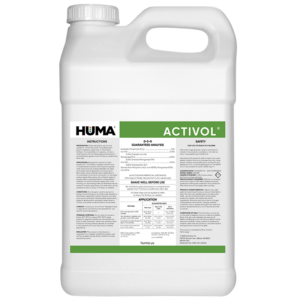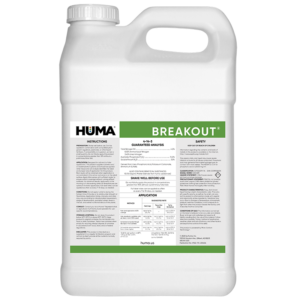44 Mag®
Benefits of Use:
- Essential core of the chlorophyll molecule
- Is active in the translocation of starches and necessary for sugar formation
- Acts as a carrier for phosphorus in the plant
- Regulates the uptake of other plant nutrients
- Enhances oil and fat formation
When to Apply:
- Low pH, high calcium, and high potash soils may reduce magnesium uptake
- Loss of green color starting at the bottom leaves and moving up the stalk; veins of leaves remain green
- Weak stalks
- Bunching-pattern root growth
- COTTON: Discolorization of leaves, turning purplish-red between the green veins, CORN: Development of an interveinal striped appearance on leaves, light yelllow to white
FAQs
Related Videos
Huma® Micronutrients and Secondary Macronutrients
Huma liquid micronutrient and secondary macronutrient fertilizers with Micro Carbon Technology (MCT) are extremely efficient. MCT improves nutrient uptake so you can get the most out of your crops. Deliver micronutrients and secondary macronutrients exactly
Learn More
Related Products
Related Case Studies
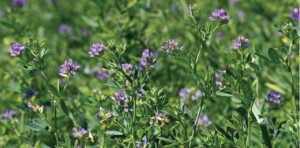
Huma® Improves Alfalfa Quality In the Southwest
Background All Huma® Inc. products are based on extractions of humic substances and other materials that can stimulate plant growth and improve crop quality. Objective The objective of this field trial was to evaluate the efficacy of applying Huma® products, specifically Encapsalt®, Super Phos®, Max Pak®, 44 Mag,® Vitol®, Super Nitro®, Breakout®, Fertil Soil®, Iro-Max®,

Huma® Improves Alfalfa Soil Biology In the Southwest
Background Industrial agriculture can degrade soil quality for crops by altering the total living microbial biomass of soil. Many practices and beneficial ag products have been introduced to the market to improve soil quality. Some of these products are humic substance-based products. Objective The objective of this trial was to evaluate the efficacy of applying

Huma® and Zia Pueblo Farm Corn Project
Background Many small-scale farms (1-2 acres each) are established in Zia Pueblo community near San Ysidro, New Mexico. Huma® Inc. was asked to establish an experimental farm in the tribal community that could demonstrate the usage of beneficial agricultural inputs producing high-yield crop and preserving the health of the soil. Huma® humic-based products stimulate plant
Related Blog Posts
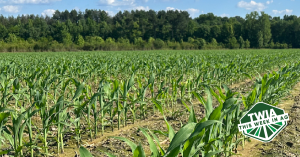
This Week in Ag #66
When asked if he was finished with planting, dad would frequently respond by saying, “the first time.” His cynicism aside, replant decisions can be difficult. This year, too many growers are faced with that decision. If you plant when the soil is cold and wet, you’re inviting problems. But even if you plant in good soil conditions,

This Week in Ag #20
Wheat harvest is well underway throughout the country. Each morning, the harvest process begins with equipment maintenance. Most farmers and custom cutters will park their fleet in a row, or in close proximity, so they can readily perform daily service. This involves the grease gun. Combines have hundreds of moving parts. Some of the most key

Field Trial: Promax® and Zap® Reduce Nematodes, Increase Yields for Green Chiles
A recent field trial on green chile peppers has concluded that Promax® and Zap® treatment is noticeably effective in lowering the parasitic nematode population while improving the beneficial microbe population. This positive effect on the soil biology boosted the yield of green chile peppers and resulted in an increased profit for the farmer.

